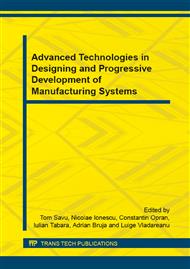p.595
p.601
p.607
p.615
p.621
p.627
p.633
p.639
p.645
Assessing Bias and Linearity of a Measurement System
Abstract:
Product and process conformance are determined by measurements that are taken by a measurement system. A clear understanding of the results of any measurement system requires an understanding of the possible errors within this system. Measurement system errors can be classified into two categories: accuracy and precision. The accuracy of a measurement system is usually broken into three components: bias, linearity and stability and the precision into repeatability and reproducibility. There are a number of procedures which are used, in the automotive and other industries to assess these statistical properties of any measurement system. Usually, companies use repeatability & reproducibility procedures but, according to a measurement systems analysis study, these may not be enough for a company that wants to meet current worldwide quality system standards. Lack of measurement equipment bias and linearity generally is not as predominant error as repeatability and reproducibility, nevertheless, it should be identified because each person that have direct responsibility for measurement evaluation, selection, and control must hand on experience in how to produce a bias and linearity study. A bias study examines the difference between the observed average of the measurements and a reference value. It answers the question “How accurate is my measurement equipment when compared to a master value ”. A linearity study tells one how accurate the measurements are through the expected range of the measurements. It answers the question “Does my measurement equipment have the same accuracy for all sizes of objects being measured ”. Determining the bias and linearity of the measuring equipments and understanding their impact on the measured values will contribute to the effectiveness of the measurement system. In this context, conception and method of bias and linearity analysis of measurement systems are introduced in this paper followed by a real world application done in a major local automotive company. The analysis had ensured consistency of measurements and provided evidence that the measurement system is functioning properly. Minitab software was used to study bias and linearity of the analyzed measurement system.
Info:
Periodical:
Pages:
621-626
Citation:
Online since:
May 2015
Authors:
Keywords:
Price:
Сopyright:
© 2015 Trans Tech Publications Ltd. All Rights Reserved
Share:
Citation:


